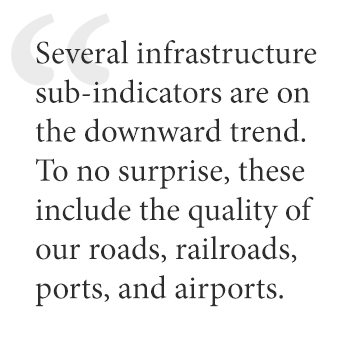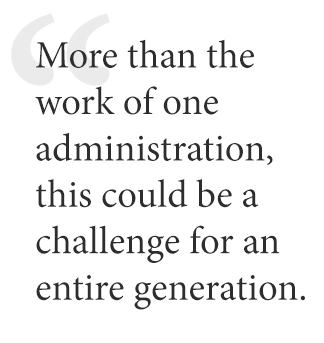Duterte's infrastructure drive: It's railing, it's pouring

"Our infrastructure may be in dire straits, but at least the administration appears to be approaching the worsening situation with open eyes." Photo by AP/Aaron Favila, file
A commentary
The World Economic Forum recently released its Global Competitiveness Report for 2017-2018, where it ranked 137 countries based on 12 categories. The Philippines ranked 56th overall, climbing up only one notch and still trailing behind its fellow members of the Association of Southeast Asian Nations (ASEAN). One of the 12 pillars is infrastructure, where the country's score remained the same but its rank dropped by two places. At 97th, the Philippines is well into the bottom half of all the countries covered.

Silver lining in spending
Our infrastructure may be in dire straits, but at least the administration appears to be approaching the worsening situation with open eyes. It has committed to investing heavily in the sector to help compensate for the years of underinvestment that have plagued it. Earlier this year, the government launched its Build, Build, Build campaign, which promises to usher in a "golden age of infrastructure." As part of its plan, it intends to spend between P8 to P9 trillion in the next six years. That's almost double the proposed national budget for 2018, which was P3.7 trillion pesos. This year alone, it set aside around P850 billion, equivalent to 5.4 percent of GDP. In context, the World Bank recommends around 5 percent.
For 2018, the infrastructure budget is planned to increase to P1,097.5 billion. This is 6.3 percent of our projected GDP for next year. Fulfilling its promise to expand infrastructure investments, the Duterte administration has raised the budgets for the Department of Transportation and the Department of Public Works and Highways, two agencies primarily tasked with implementing infrastructure projects.
For example, the 2018 DOTr budget will increase by one third, or 33 percent, amounting to some P73.8 billion. Around 48 percent of the agency's budget will be spent on the proposed railways, around 24 percent will be spent on road-based transport projects, while 18.5 percent will be set aside for spending on aviation projects.
On the other hand, DPWH will get a 38 percent increase in its budget for next year, amounting to P6.43 billion, ranking second among all government agencies, next only to the Department of Education. Around 26 percent of the agency's budget is meant to be spent on projects geared toward improving the sustainability and resilience of communities nationwide—an especially important point for reducing our country's vulnerability to the hazards of climate change.
For those of us living in highly-clogged urban areas, another 25 percent of the DPWH budget will be used to reduce the congestion of traffic along our thoroughfares. Complementing this, 15 percent will be used to make our transport system more integrated and seamless. Examples of this are the Mindanao infrastructure logistics network, inter-island linkages nationwide, and connecting gaps along existing national roads. Geographically, almost half of the agency's budget will be spent for projects in Luzon, a third will be allocated for Mindanao, and the rest will be spent on projects in the Visayas region.
Alongside increasing infrastructure spending, the government has also taken strides to hasten and streamline the approval of various infrastructure projects in the pipeline, where some have stagnated since the Aquino administration. As of September 2017, the board of the National Economic Development Authority has already approved 35 projects worth some P1.2 trillion.
Varieties of financing
Unlike its predecessor, the Duterte administration has favored financing from Official Development Assistance loans over Public-Private Partnerships, arguing that the latter take longer to implement. ODAs have been a key resource for governments in implementing its priority projects. Under the Duterte administration, two-thirds of the NEDA-Board approved projects will reportedly be funded by ODA loans, amounting to P1.074 trillion.
Japan has been one of the country's longest developing partners, and for the first semester of the 2017, Japan still remains the Philippines' top ODA partner. In contrast, China is not even among our top 10 ODA partners. However, the warmer ties with China under the Duterte administration might change that sooner rather than later. The government is already negotiating with its Chinese counterpart to finance at least three projects.
Some of the administration's big-ticket ODA projects are the North and South commuter lines of the Philippine National Railway spearheaded by the DOTr. In November 2016, the NEDA Board approved the South Line Project of the PNR, worth around P299.4 billion. The government tapped China to finance the project, which will consist of a 72-kilometer commuter line between Solis-Hermosa station in Manila and Los Baños, Laguna and a 581-km long-haul line that will link Manila, Laguna, Batangas, Quezon, Albay, Camarines Sur and Sorsogon.

Conclusion
It's good news that the Philippines is attempting to climb out the hole that its infrastructure has been in for decades. In the short run, we should begin to turn our eyes into the implementation and operationalization of all of these projects. The future of this country deserves continued diligence from our parts to ensure that we are doing more than trapping ourselves in a debt burden.
To end, catching up with our neighbors is one thing, but transforming our transportation system into a fully functioning and integrated system is another.
More than the work of one administration, this could be a challenge for an entire generation.
- Latest
- Trending































